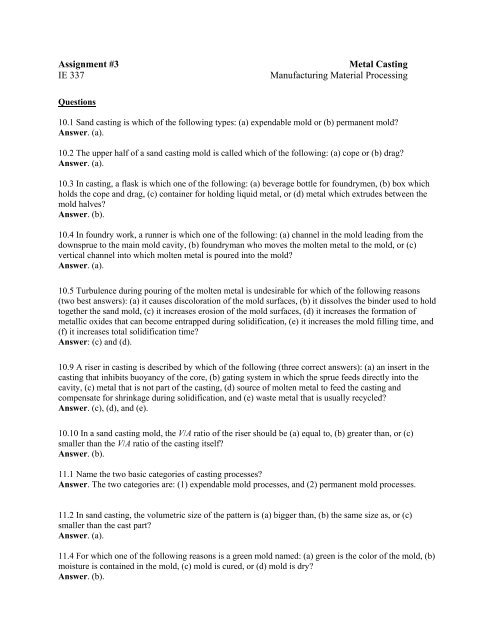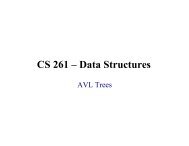Assignment #3 Metal Casting IE 337 Manufacturing Material - Classes
Assignment #3 Metal Casting IE 337 Manufacturing Material - Classes
Assignment #3 Metal Casting IE 337 Manufacturing Material - Classes
Create successful ePaper yourself
Turn your PDF publications into a flip-book with our unique Google optimized e-Paper software.
<strong>Assignment</strong> <strong>#3</strong> <strong>Metal</strong> <strong>Casting</strong><br />
<strong>IE</strong> <strong>337</strong> <strong>Manufacturing</strong> <strong>Material</strong> Processing<br />
Questions<br />
10.1 Sand casting is which of the following types: (a) expendable mold or (b) permanent mold?<br />
Answer. (a).<br />
10.2 The upper half of a sand casting mold is called which of the following: (a) cope or (b) drag?<br />
Answer. (a).<br />
10.3 In casting, a flask is which one of the following: (a) beverage bottle for foundrymen, (b) box which<br />
holds the cope and drag, (c) container for holding liquid metal, or (d) metal which extrudes between the<br />
mold halves?<br />
Answer. (b).<br />
10.4 In foundry work, a runner is which one of the following: (a) channel in the mold leading from the<br />
downsprue to the main mold cavity, (b) foundryman who moves the molten metal to the mold, or (c)<br />
vertical channel into which molten metal is poured into the mold?<br />
Answer. (a).<br />
10.5 Turbulence during pouring of the molten metal is undesirable for which of the following reasons<br />
(two best answers): (a) it causes discoloration of the mold surfaces, (b) it dissolves the binder used to hold<br />
together the sand mold, (c) it increases erosion of the mold surfaces, (d) it increases the formation of<br />
metallic oxides that can become entrapped during solidification, (e) it increases the mold filling time, and<br />
(f) it increases total solidification time?<br />
Answer: (c) and (d).<br />
10.9 A riser in casting is described by which of the following (three correct answers): (a) an insert in the<br />
casting that inhibits buoyancy of the core, (b) gating system in which the sprue feeds directly into the<br />
cavity, (c) metal that is not part of the casting, (d) source of molten metal to feed the casting and<br />
compensate for shrinkage during solidification, and (e) waste metal that is usually recycled?<br />
Answer. (c), (d), and (e).<br />
10.10 In a sand casting mold, the V/A ratio of the riser should be (a) equal to, (b) greater than, or (c)<br />
smaller than the V/A ratio of the casting itself?<br />
Answer. (b).<br />
11.1 Name the two basic categories of casting processes?<br />
Answer. The two categories are: (1) expendable mold processes, and (2) permanent mold processes.<br />
11.2 In sand casting, the volumetric size of the pattern is (a) bigger than, (b) the same size as, or (c)<br />
smaller than the cast part?<br />
Answer. (a).<br />
11.4 For which one of the following reasons is a green mold named: (a) green is the color of the mold, (b)<br />
moisture is contained in the mold, (c) mold is cured, or (d) mold is dry?<br />
Answer. (b).
11.6 Which of the following casting processes are expendable mold operations (four correct answers): (a)<br />
centrifugal casting, (b) die casting, (c) investment casting, (d) low pressure casting, (e) sand casting, (f)<br />
shell molding, (g) slush casting, and (h) vacuum molding?<br />
Answer. (c), (e), (f), and (h).<br />
11.10 Which of the following qualifies as a precision casting process (two correct answers): (a) ingot<br />
casting, (b) investment casting, (c) plaster mold casting, (d) sand casting, and (c) shell molding?<br />
Answer. (b) and (c).<br />
11.11 Which of the following casting processes are permanent mold operations (three correct answers):<br />
(a) centrifugal casting, (b) die casting, (c) expanded polystyrene process, (d) sand casting, (e) shell<br />
molding, (f) slush casting, and (g) vacuum molding.<br />
Answer. (a), (b), and (f).<br />
11.12 Which of the following metals would typically be used in die casting (three best answers): (a)<br />
aluminum, (b) cast iron, (c) steel, (d) tin, (e) tungsten, and (f) zinc?<br />
Answer. (a), (d), and (f).<br />
11.13 Which of the following are advantages of die casting over sand casting (four best answers): (a)<br />
better surface finish, (b) closer tolerances, (c) higher melting temperature metals, (d) higher production<br />
rates, (e) larger parts can be cast, and (f) mold can be reused?<br />
Answer. (a), (b), (d), and (f).<br />
Problems<br />
6.3 Using the lead-tin phase diagram in Figure 6.3, determine the liquid and solid phase compositions for<br />
a nominal composition of 40% Sn and 60% Pb at 204°C (400°F).<br />
Solution: From Fig 6.3, the compositions are observed as follows:<br />
Liquid phase composition = 56% Sn - 44% Pb.<br />
α phase composition = 18% Sn - 82% Pb.<br />
NOTE TO GRADER: Please realize that these values are taken from a graph so some leniency<br />
warranted.<br />
6.4 For the preceding problem, use the inverse lever rule to determine the proportions of liquid and solid<br />
phases present in the alloy.<br />
Solution: From Fig 6.3, measured values of CL and CS are: CL = 10.5 mm, CS = 15 mm.<br />
Liquid phase proportion = 15/(15 + 10.5) = 15/25.5 = 0.59<br />
α phase proportion = 10.5/25.5 = 0.41
NOTE TO GRADER: Please realize that these values are taken from a graph so some leniency<br />
warranted.<br />
10.1 A disk 40 cm in diameter and 5 cm thick is to be cast of pure aluminum in an open mold casting<br />
operation. The melting temperature of aluminum = 660°C and the pouring temperature will be 800°C.<br />
Assume that the amount of aluminum heated will be 5% more than what is needed to fill the mold cavity.<br />
Compute the amount of heat that must be added to the metal to heat it to the pouring temperature, starting<br />
from a room temperature of 25°C. The heat of fusion of aluminum = 389.3 J/g. Other properties can be<br />
obtained from Tables 4.1 and 4.2 in the text. Assume the specific heat has the same value for solid and<br />
molten aluminum.<br />
Solution: Volume V = πD 2<br />
h/4= π(40) 2<br />
(5)/4 = 6283.2 cm 3<br />
Volume of aluminum to be heated = 6283.2(1.05) = 6597.3 cm 3<br />
From Table 4.1 and 4.2, density ρ = 2.70 g/cm 3<br />
and specific heat C = 0.21 Cal/g-°C = 0.88 J/g-°C<br />
Heat required = 2.70(6597.3){0.88(660-25) + 389.3 + 0.88(800-660)}<br />
= 17,812.71{558.8 + 389.3 + 123.2} = 19,082,756 J<br />
10.7 Molten metal can be poured into the pouring cup of a sand mold at a steady rate of 1000 cm 3<br />
/s. The<br />
molten metal overflows the pouring cup and flows into the downsprue. The cross-section of the sprue is<br />
round, with a diameter at the top = 3.4 cm. If the sprue is 25 cm long, determine the proper diameter at its<br />
base so as to maintain the same volume flow rate.<br />
Solution: Velocity at base v = (2gh) 0.5<br />
= (2 x 981 x 25) 0.5<br />
= 221.5 cm/s<br />
Assuming volumetric continuity, area at base A = (1000 cm 3 /s)/(221.5 cm/s) = 4.51 cm 2<br />
Area of sprue A = πD 2<br />
/4; rearranging, D 2<br />
= 4A/π = 4(4.51)/π = 5.74 cm 2<br />
D = 2.39 cm<br />
10.21 The total solidification times of three casting shapes are to be compared: (1) a sphere, (2) a cylinder,<br />
in which the length-to-diameter ratio = 1.0, and (3) a cube. For all three geometries, the volume = 1000<br />
cm 3<br />
. The same casting alloy is used in the three cases. (a) Determine the relative solidification times for<br />
each geometry. (b) Based on the results of part (a), which geometric element would make the best riser?<br />
(c) If the mold constant = 3.5 min/cm 2<br />
in Chvorinov's Rule, compute the total solidification time for each<br />
casting.<br />
Solution: For ease of computation, make the substitution 10 cm = 1 decimeter (1 dm). Thus 1000 cm 3<br />
=<br />
1.0 dm 3<br />
.<br />
(1) Sphere volume V = πD 3<br />
/6 = 1.0 dm 3<br />
. D 3<br />
= 6/π = 1.910 dm 3<br />
. D = (1.910) 0.333<br />
= 1.241 dm<br />
Sphere area A = πD 2<br />
= π(1.241) 2<br />
= 4.836 dm 2<br />
V/A = 1.0/4.836 = 0.2067 dm<br />
Chvorinov’s Rule T TS = (0.2067) 2<br />
C m = 0.0428C m<br />
(2) Cylinder volume V = πD 2<br />
H/4 = πD 3<br />
/4 = 1.0 dm 3<br />
. D 3<br />
= 4/π = 1.273 dm 3
Therefore, D = H = (1.273) 0.333<br />
= 1.084 dm<br />
Cylinder area A = 2πD 2<br />
/4 + πDL = 2π(1.084) 2<br />
/4 + π(1.084)(1.084) = 5.536 dm 2<br />
V/A = 1.0/5.536 = 0.1806 dm<br />
Chvorinov’s Rule T = (0.1806)<br />
TS 2<br />
C = 0.0326C<br />
m m<br />
(3) Cube: V = L 3<br />
=1.0 dm 3<br />
. L = 1.0 dm<br />
Cube area = 6L 2<br />
= 6(1) 2<br />
= 6.0 dm 2<br />
V/A = 1.0/6.0 = 0.1667 dm<br />
Chvorinov’s Rule T = (0.1667)<br />
TS 2<br />
C = 0.02778C<br />
m m<br />
(b) Sphere would be the best riser, since V/A ratio is greatest.<br />
(c) Given that C m = 3.5 min/cm 2<br />
= 350 min/dm 3<br />
Sphere: T = 0.0428(350) = 14.98 min<br />
TS<br />
Cylinder: T = 0.0326(350) = 11.41 min<br />
TS<br />
Cube: T = 0.02778(350) = 9.72 min<br />
TS<br />
10.24 A cylindrical riser is to be designed for a sand casting mold. The length of the cylinder is to be 1.25<br />
times its diameter. The casting is a square plate, each side = 10 in and thickness = 0.75 inch. If the metal<br />
is cast iron, and the mold constant = 16.0 min/in 2<br />
in Chvorinov's Rule, determine the dimensions of the<br />
riser so that it will take 30% longer for the riser to solidify.<br />
Solution: <strong>Casting</strong> volume V = tL 2<br />
= 0.75(10.0) 2<br />
= 75 in 3<br />
<strong>Casting</strong> area A = 2L 2<br />
+ 4Lt = 2(10.0) 2<br />
+ 4(10.0)(0.75) = 230.0 in 2<br />
V/A = 75/230 = 0.3261<br />
<strong>Casting</strong> T = 16(0.3261)<br />
TS 2<br />
= 1.70 min<br />
Riser T = 1.30(1.70) = 2.21 min<br />
TS<br />
Riser volume V = πD 2<br />
H/4 = 0.25πD 2<br />
(1.25D) = 0.3125πD 3<br />
Riser area A = 2πD 2<br />
/4 + πDH = 0.5πD 2<br />
+ 1.25πD 2<br />
= 1.75πD 2<br />
V/A = 0.3125πD 3<br />
/1.75πD 2<br />
= 0.1786D<br />
Riser T = 16.0(0.1786D)<br />
TS 2<br />
= 16.0(0.03189)D 2<br />
= 0.5102D 2<br />
= 2.21 min<br />
D 2<br />
= 2.21/0.5102 = 4.3316<br />
D = (4.3316) 0.5<br />
= 2.081 in<br />
H = 1.25(2.081) = 2.602 in.

















